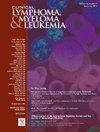治疗里希特氏病的当代标准疗法和未来方向
IF 2.7
4区 医学
Q2 HEMATOLOGY
引用次数: 0
摘要
本文章由计算机程序翻译,如有差异,请以英文原文为准。
SOHO State of the Art Updates and Next Questions | Contemporary Standard of Care Therapy for Richter's Transformation and Future Directions
Richter's transformation (RT) is a life-threatening evolution of chronic lymphocytic leukemia (CLL) into a more aggressive lymphoma, typically diffuse large B-cell lymphoma (DLBCL), marking a challenging juncture in CLL management due to the associated poor prognosis and limited treatment options. This review delves into the current therapeutic landscape for RT. Despite the modest efficacy of traditional chemoimmunotherapy (CIT) regimens such as R-CHOP and its variations, this regimen remains the most commonly recommended standard of care. Multiple therapeutic strategies are under investigation, including targeted kinase inhibitors, checkpoint inhibitors, bispecific antibodies, and CAR T therapy. Given the complex nature of RT and the evolving therapeutic paradigms, ongoing research is imperative to refine treatment strategies and integrate novel therapeutic agents to enhance survival and quality of life for people with RT. Given the lack of a clear standard of approach in the management of RT, patients with RT should be prioritized to enroll on clinical trials where feasible.
求助全文
通过发布文献求助,成功后即可免费获取论文全文。
去求助
来源期刊

Clinical Lymphoma, Myeloma & Leukemia
ONCOLOGY-HEMATOLOGY
CiteScore
2.70
自引率
3.70%
发文量
1606
审稿时长
26 days
期刊介绍:
Clinical Lymphoma, Myeloma & Leukemia is a peer-reviewed monthly journal that publishes original articles describing various aspects of clinical and translational research of lymphoma, myeloma and leukemia. Clinical Lymphoma, Myeloma & Leukemia is devoted to articles on detection, diagnosis, prevention, and treatment of lymphoma, myeloma, leukemia and related disorders including macroglobulinemia, amyloidosis, and plasma-cell dyscrasias. The main emphasis is on recent scientific developments in all areas related to lymphoma, myeloma and leukemia. Specific areas of interest include clinical research and mechanistic approaches; drug sensitivity and resistance; gene and antisense therapy; pathology, markers, and prognostic indicators; chemoprevention strategies; multimodality therapy; and integration of various approaches.
 求助内容:
求助内容: 应助结果提醒方式:
应助结果提醒方式:


